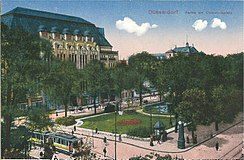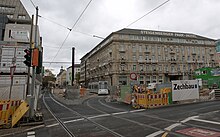Corneliusplatz
| Corneliusplatz | |
|---|---|
| Place in Düsseldorf | |
 Corneliusplatz around 1912 in front of the Tietz department store, today Kaufhof . At the bottom right the street clock “Green Mathilde”. |
|
| Basic data | |
| place | Dusseldorf |
| District | City center |
| Newly designed | probably 2013 |
| Confluent streets | Schadowstrasse , Elberfelder Strasse, Königsallee |
| Buildings | Bowl fountain, Kaufhof |
| use | |
| User groups | Pedestrian traffic , bicycle traffic , car traffic , public transport |
| Space design | Green space |
| Technical specifications | |
| Square area | approx. 2,500 m² |

The Corneliusplatz lies between the Triton Fountain at the north end of the channel of the King Avenue and the southern edge of the courtyard garden in the midst of Düsseldorf city center . As a Wilhelmine jewelry place , its green area was one of the most beautiful and popular in all of Düsseldorf. In 1882, a neo-baroque bowl fountain based on a design by the sculptor Leo Müsch was set up in its center . The square is named after Peter von Cornelius , the first director of the Düsseldorf Art Academy , whose monument stands in the Hofgarten and which forms the focal point of the line of sight of Corneliusplatz to the north.
history
The square formed the connection from the courtyard garden to the urban, built-up area with the buildings of the Parkhotel today on Königsallee, formerly at Corneliusplatz 1, on the western and the former Trinkaus-Palais , on the corner of Hofgartenstrasse 14, on the eastern side.
From the last third of the 19th century, a number of houses with the best view of the Hofgarten were built along Hofgartenstrasse. In 1865 part of the Botanical Garden, which was on the former moat in the Hofgarten on Alleestrasse, was given away for the new construction of the opera house . With the construction of the theater, from 1873 to 1875, the areas of the court garden were connected to the Königsallee and the canal-like extension of the Landskronenwasser to the Königsallee moat was removed. On the area gained, two squares with an axial reference to Königsallee were created, the Corneliusplatz with the Cornelius monument placed in the middle and the Schmuckplatz with a bowl fountain.
The area in front of the Parkhotel was redesigned in 1879 as part of the unveiling of the Cornelius monument , created by the Dresden sculptor Adolf von Donndorf . The installation costs at that time were 25,000 thalers.
The neo-baroque bowl fountain designed by the sculptor Leo Müsch was set up in the middle of the jewelry square in 1882. In connection with the installation of the fountain, the square was laid out according to plans by city gardener Friedrich Hillebrecht . According to designs by the gardening director Walter von Engelhardt (1864–1940), further horticultural changes were made in the area of Corneliusplatz and the war memorial around 1920, which resulted in the Cornelius memorial being shifted sideways from the center to the edge of the square. In 1934 the square was renamed Albert-Leo-Schlageter- Platz as part of the renaming of the western side of Königsallee . On March 23, 1937, the Cornelius monument was moved 30 meters north to its current location at the beginning of the Königsallee at the Hofgarten. In 1994 Corneliusplatz at the Schalenbrunnen was entered as a garden monument in the list of monuments of the state capital Düsseldorf.
Starting in 2007, the entire area of the square was a construction site for ten years for the construction of the Heinrich-Heine-Allee underground station and the Wehrhahn Line information center .
Former importance of the square in the road network
Until construction began on the Wehrhahn Line with the expansion of the Heinrich-Heine-Allee subway station and then the Kö-Bogen on the old Jan-Wellem-Platz in 2007, the square was east of the Kaufhof between the two sides of the Königsallee , in It was bordered to the north by Elberfelder Strasse and to the south by Theodor-Körner-Strasse. The place was free of private traffic with a planting of magnolia trees and flower beds as well as the bowl fountain and the benches. The delimiting streets were heavily used traffic connections between the old core city in the direction of Schadowstraße , Berliner Allee , Kaiserstraße and the old Jan-Wellem-Platz with its stops for local tram and bus routes .
Construction site Corneliusplatz
On November 28, 2007, the groundbreaking ceremony took place for a new underground line , the Wehrhahn Line . From the end of 2007, the entire area of Corneliusplatz was used for the construction site facilities. The bowl fountain was dismantled and stored. The magnolia trees on the square were replanted in 2008 for later reuse in the municipal tree nursery to restore the square to its largely original condition. After work on the Wehrhahn Line began in 2008, a two-story information center was set up on the redesign of the urban area in the vicinity of the park.
Extensive temporary interim solutions had to be made for the construction of the subway tunnels and the underground roads to be laid. This particularly affected Elberfelder Strasse in the Kaufhof and Parkhotel area and the new Kö-Bogen. Until the completion of the road tunnel between Hofgartenstrasse and Elberfelder Strasse and the underground tunnel in this area of the street, particularly elaborate temporary arrangements had to be made for the tram tracks between Jan-Wellem-Platz and Heinrich-Heine-Allee (Düsseldorf) .
The previous road connections between the northern Königsallee and Hofgartenstrasse and the eastern part of Elberfelder Strasse were canceled after the tunnel was completed. The street boundary of the square in the north became a pedestrian area with a connection to the Kö-Bogen and the Hofgarten. The street area in the east of the square was closed and the additional east entrance for the Heinrich-Heine-Allee underground station was created on its site .
From the end of winter 2016/2017, the construction site facilities on the square were gradually dismantled and the restoration of the square began taking into account the historical plans. The bowl fountain was restored for almost half a million euros from November 2016 and war damage and deficiencies in the water technology were repaired. From mid-April 2017, the well was rebuilt and provided with the necessary inflows and outflows for the water. A successful hydraulic check took place on August 21, 2017. A complete completion of the square with the complete replanting is only planned for the beginning of 2018. However, the original magnolia trees that were replanted will be replaced by twelve new ones, as the old ones "survived" but were not in "good condition".
Except for the traffic on Theodor-Körner-Straße and the outflowing traffic from the parking garage of the Kaufhof in the area of the western Königsallee, the original car traffic in the area of the square has largely been relocated to the new road tunnels. The tracks of the tram on Elberfelder Straße have also been dismantled and also disappeared underground. Instead, Corneliusplatz has now been given a direct, ground-level connection to the Hofgarten and the Kö-Bogen area.
During the construction phase, the historical normal clock Grüne Mathilde , which stood on the north corner of Theodor-Körner-Straße and the east side of Königsallee, was dismantled and restored. Due to the changed tree locations compared to the previous situation, the clock is no longer exactly in the old place.
outlook
The final completion of the square with its planting should take place at the end of January 2018, at the end of March 2018 it was largely completed but the square was not yet accessible. It was delayed by the construction of a 1700 m² ice rink. This large ice surface replaced a significantly smaller one, which was laid out and operated every year in December from 1999 until construction began in the northern area of the square in front of Elberfelder Straße. The new large ice rink was opened on November 23, 2017 and operated until January 28, 2018. The already built bowl fountain, which is located in the middle of the ice rink, was protected accordingly. From 2019 onwards, all facilities and plantings are to be protected through overbuilding and other measures. As of February 2018
Web links
Individual evidence
- ↑ Article on WZ-online
- ^ List of renamed streets in the Düsseldorf address book, 1934
- ↑ Peter von Cornelius Monument , to the Digital Art and Culture Archive Düsseldorf (d: kult)
- ↑ Info-Center on düsseldorf.de
- ^ In: Stadtchronik Düsseldorf 2007 . November
- ↑ In: RP Online from August 16, 2017 , The old magnolias are not returning.
- ↑ a b In: RP Online from August 21, 2017 , The bowl fountain is bubbling again
- ↑ Juliane Kinast: Corneliusplatz becomes a square again . Article from January 10, 2016 in the portal wz.de , accessed on January 10, 2016
- ^ In: RP Online from December 21, 2016 . DEG wants to take over the ice rink on the Kö
- ↑ In: RP Online from November 21, 2017 . Test Kö ice rink
- ↑ In: Solinger Tageblatt Online from November 12, 2017 . Corneliusplatz-ice rink-Christmas markets-open-November
Coordinates: 51 ° 13 ′ 33 ″ N , 6 ° 46 ′ 44 ″ E

